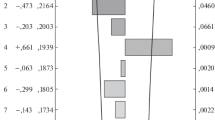Summary
The survival time of small and isolated populations will often be relatively low, by which the survival of species living in such a way will depend on powers of dispersal sufficiently high to result in a rate of population foundings that about compensates the rate of population extinctions. The survival time of composite populations uninterruptedly inhabiting large and heterogeneous areas, highly depends on the extent to which the numbers fluctuate unequally in the different subpopulations. The importance of this spreading of the risk of extinction over differently fluctuating subpopulations is demonstrated by comparing over 19 years the fluctuation patterns of the composite populations of two carabid species, Pterostichus versicolor with unequally fluctuating subpopulations, and Calathus melanocephalus with subpopulations fluctuating in parallel, both uninterruptedly occupying the same large heath area. The conclusions from the field data are checked by simulating the fluctuation patterns of these populations, and thus directly estimating survival times. It thus appeared that the former species can be expected to survive more than ten times better than the latter (other things staying the same). These simulations could also be used to study the possible influence of various density restricting processes in populations already fluctuating according to some pattern. As could be expected, the survival time of a population, which shows a tendency towards an upward trend in numbers, will be favoured by some kind of density restriction, but the degree to which these restrictions are density-dependent appeared to be immaterial. Density reductions that are about adequate on the average need even not occur at high densities only, if only the chance of occurrence at very low densities is low. The density-level at which a population is generally fluctuating appeared to be less important for survival than the fluctuation pattern itself, except for very low density levels, of course. The different ways in which deterministic and stochastic processes may interact and thus determine the fluctuations of population numbers are discussed. It is concluded that some stochastic processes will operate everywhere and will thus necessarily result in density fluctuations; such an omnipresence is much less imperative, however, for density-dependent processes, by which population models should primarily be stochastic models. However, if density-dependent processes are added to model populations, that are already fluctuating stochastically the effects are taken up into the general, stochastic fluctuation pattern, without altering it fundamentally.
Similar content being viewed by others
References
Andrewartha HG (1957) The use of conceptual models in population ecology. Cold Spring Harb Symp quant Biol 22:219–236
Andrewartha HG, Birch LC (1954) The distribution and abundance of animals. Chicago Univ Press, Chicago, p 782
Baars MA (1979a) Patterns of movement of radioactive carabid beetles. Oecologia (Berl) 44:125–140
Baars MA (1979b) Catches in pitfall traps in relation to mean densities of carabid beetles. Oecologia (Berl) 41:25–46
Bakker K (1964) Backgrounds of controversies about population theories and their terminologies. Z angew Entom 53:187–208
Bakker K (1971): Some general remarks on the concepts “population” and “regulation”. Proc Adv Study Inst Dynamics numbers Pop (Oosterbeek 1970):565–567
Den Boer PJ (1968) Spreading of risk and stabilization of animal numbers. Acta Biotheor 18:165–194
Den Boer PJ (1970) On the significance of dispersal power for populations of Carabid-beetles (Coleoptera, Carabidae). Oecologia (Berl) 4:1–28
Den Boer PJ (1971) Stabilization of animal numbers and the heterogeneity of the environment: The problem of the persistence of sparse populations. Proc Adv Study Inst Dynamics numbers Pop (Oosterbeek 1970):77–97
Den Boer PJ (1977) Dispersal power and survival. Carabids in a cultivated countryside. Miscell papers LH Wageningen 14, p 190
Den Boer PJ (1979a) The significance of dispersal power for the survival of species, with special reference to the carabid beetles in a cultivated countryside. Fortschr Zool 25 2/3:79–94
Den Boer PJ (1979b) Populations of Carabid beetles and individual behaviour. General aspects. Miscell Papers LH Wageningen 18:145–149
Den Boer PJ (1981) On the stability of animal populations, or how to survive in a heterogeneous and changeable world? Paper read at Bremen Univ, will be published in Fortschr Zool
Dingle H (1978) Evolution of insect migration and diapause. Springer Verlag, Berlin Heidelberg New York, p 350
Hassell MP (1978) The dynamics of arthropod predator-prey systems. Monogr Pop Biol 13, p 237
Johnson CG (1969) Migration and dispersal of insects by flight. Methuen, London, p 763
Juberthie C (1979) L'évolution des coléoptères Trechinae souterrains (Coleoptera, Carabidae). Miscell Papers LH Wageningen 18:83–99
Klomp H, van Montfort MAJ, Tammes PML (1964) Sexual reproduction and underpopulation. Arch Néerl Zool 16:105–110
Kuhn TS (1970) The structure of scientific revolutions. 2nd enlarged edn. Univ of Chicago Press, Chicago, p 210
Kuno E (1971) Sampling error as a misleading artefact in “key factor analysis” Res Popul Ecol 13:28–45
Kuno E (1981) Dispersal and the persistence of populations in unstable habitats: A theoretical note. Oecologia (Berlin) 49:123–126
Luff ML (1975) Some features influencing the efficiency of pitfall traps. Oecologia (Berl) 19:345–357
May RM (1973) Stability and complexity in model ecosystems. Monogr Pop Biol 6, p 235
Milne A (1957) Theories on natural control of insect populations. Cold Spring Harb Symp quant Biol 25:253–271
Milne A (1962) A theory of natural control of insect populations. J theor Biol 3:19–50
Murdoch WW (1979) Predation and the dynamics of prey populations. Fortschr Zool 25 2/3:296–310
Reddingius J (1971) Gambling for existence. A discussion of some theoretical problems in animal population ecology. Acta Biotheor 20 (suppl) 1–208
Reddingius J, den Boer PJ (1970) Simulation experiments illustrating stabilization of animal numbers by spreading of risk. Oecologia (Berl) 5:240–284
Southwood TRE (1962) Migration of terrestrial arthropods in relation to habitat. Biol Rev 37:171–214
Turanchik EJ, Kane TC (1979) Ecological genetics of the cave beetle Neaphaenops tellkampfii (Coleoptera, Carabidae). Oecologia (Berl) 44:63–67
Van Dijk Th S (1981) Individual variability and its significance for the survival of animal populations. Paper read at Bremen Univ, will be published in Fortschr Zool
Watt KEF (1971) Dynamics of populations: A synthesis Proc Adv Study Inst Dynamics numbers Pop (Oosterbeek 1970) 568–580
Wolda H (1978a) Fluctuations in abundance of tropical insects. The Amer Naturalist 112:1017–1045
Wolda H (1978b) Seasonal fluctuations in rainfall, food and abundance of tropical insects. J anim Ecol 47:369–381
Zwölfer H (1978) Mechanismen und Ergebnisse der Co-Evolution von phytophagen und entomophagen Insekten und höheren Pflanzen. Sonderbd. naturw Ver Hamburg 2:7–50
Zwölfer H (1979) Strategies and counterstrategies in insect population systems competing for space and food in flower heads and plant galls. Fortschr Zool 25 2/3:331–353
Author information
Authors and Affiliations
Additional information
Dedicated to Professor Michael Evenari
Communication No. 228 of the Biological Station Wijster
Rights and permissions
About this article
Cite this article
den Boer, P.J. On the survival of populations in a heterogeneous and variable environment. Oecologia 50, 39–53 (1981). https://doi.org/10.1007/BF00378792
Received:
Issue Date:
DOI: https://doi.org/10.1007/BF00378792




